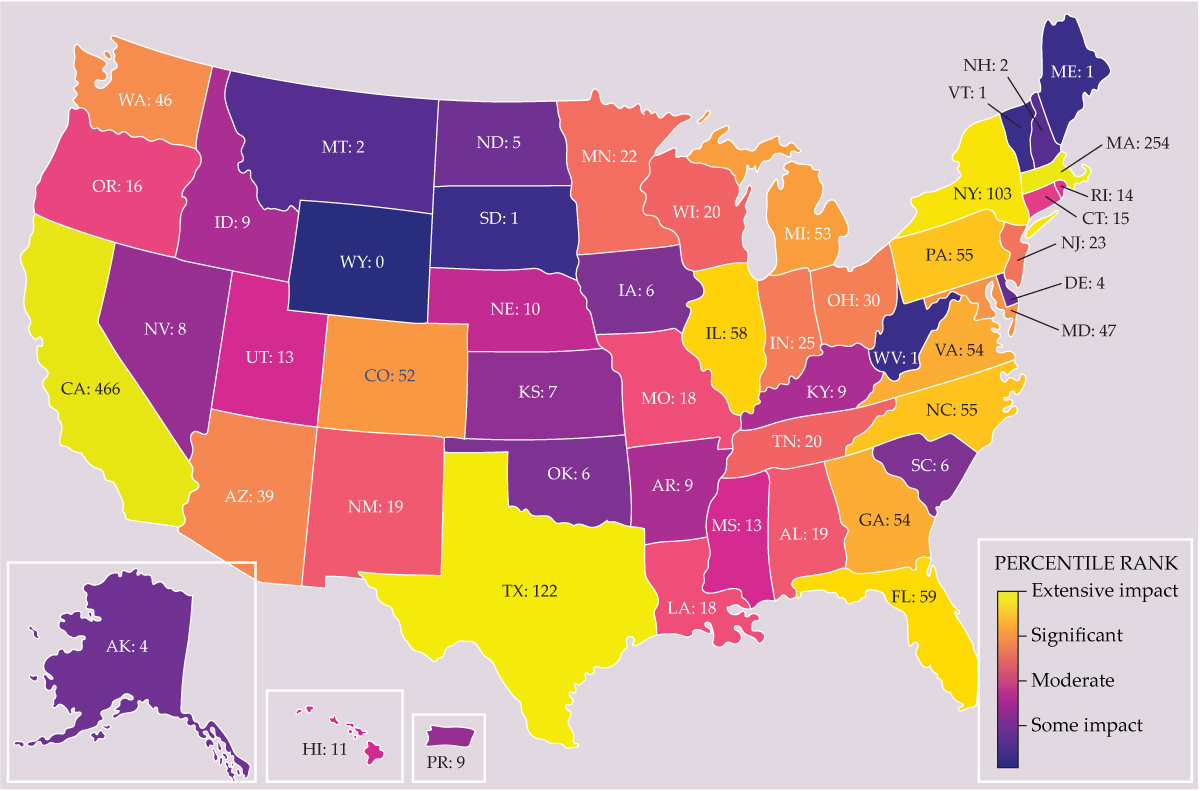A crowdsourced database tracks US science grant cancellations
DOI: 10.1063/pt.vwxi.xowh

A map of NSF grant impacts by state, created from Grant Witness data, reveals the hot spots nationwide as of 29 August. The numbers and colors indicate the total number of grants impacted, including canceled and possibly reinstated grants. (Image courtesy of Grant Witness.)

In the spring, NSF began canceling some previously awarded grants. The cuts targeted research
Noam Ross, a computational researcher and executive director at the nonprofit rOpenSci, and Scott Delaney, a Harvard University social and environmental epidemiologist, launched the tracker in March to track National Institutes of Health grant cancellations. NIH had posted conflicting information about the extent of the cuts, says Ross, so he and Delaney started collecting a list of grants through submissions from affected principal investigators, court filings, and official lists when available. The two researchers vetted submissions by comparing them with publicly available federal award identification numbers and the government’s spending database tool, USAspending.gov
Grant Witness began tracking NSF grants in April when the agency announced the first round of cuts. A small group of organizers helps Ross and Delaney regularly update the lists to reflect new cancellations or reinstatements. Ross has spent about $100 out of pocket to host the website, and the group received a small grant from the Alfred P. Sloan Foundation to fund one person for a few hours a week. All other organizers volunteer their time. Ross says the group is seeking more funding to support the work.
The cuts hit home for the Grant Witness team in May: Delaney’s grants were terminated when the administration canceled all NIH funding to Harvard. Delaney says he expects to lose his job at Harvard as a result.
Grant cancellations by the numbers
As of 29 August, the database lists 1552 canceled NSF grants across all disciplines. In many cases, awardees have already received a portion of their funding. The cumulative remaining value of the canceled grants is about $860 million, according to Grant Witness.
Another 417 NSF grants are labeled in the database as “possibly reinstated.” Those funds have been restored by successful appeals, university settlements with the federal government, or court orders, such as the preliminary injunction
Physics and astronomy divisions in NSF’s Directorate for Mathematical and Physical Sciences (MPS) have been affected by the cuts. Twenty-nine grants were canceled and 17 marked as “possibly reinstated” as of 29 August. Among those canceled are an astrophysics education program for American Indian and Alaska Native scientists at the University of Minnesota Twin Cities and an initiative to mentor and train new physical scientists across nine universities.
Twenty of the canceled grants supported physics and astronomy studies at Harvard, including research on supernovae, quantum nanophotonics systems, and miniaturized chemical computing devices. Sixteen physics and astronomy grants at the University of California, Los Angeles, were marked as “possibly reinstated” in August after a federal judge ordered the administration to unfreeze the school’s nearly 800 affected science grants. (The Justice Department froze the grants
Compared with other divisions in the MPS, the cuts to physics and astronomy are on par with those to chemistry, which has had 31 total grants affected, and materials research, at 26, but they are smaller than the cuts to mathematical sciences at 88. The MPS’s total of 196 pales in comparison with the 805 grants affected in the Directorate for STEM Education.
Information as power
Other trackers have cropped up too. Users can browse federal layoffs, terminations to contracts and leases, hiring freezes, and other cuts on the Impact Map
Providing accessible and transparent data for public advocacy and litigation is the main goal of Grant Witness, says Ross. The tracker has been used in evidence in five lawsuits and to prep speakers for congressional testimony. Ross says Grant Witness served as the inspiration for a campaign to publish op-eds in every state to highlight the impacts of cuts on local communities.
This article was originally published online on 4 September 2025.

